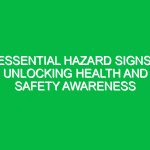Introduction
In various workplaces, be it construction sites, laboratories, or offices, hazard and Safety symbols play a critical role in ensuring health, safety, and environmental (HSE) compliance. These symbols serve as visual cues, alerting individuals to potential dangers and promoting Safe Practices. Understanding these symbols is not just beneficial; it is essential for creating a safe working Environment. This article aims to be a Comprehensive Guide to hazard and Safety symbols, exploring their significance, application, and the Regulations surrounding them.
The Importance of Hazard and Safety Symbols
Hazard and safety symbols effectively communicate risks that may not be immediately apparent. For example, a simple triangle with an exclamation mark may indicate a general warning, while a skull and crossbones signifies toxic substances. The use of standardized symbols helps in transcending language barriers, making it easier for everyone, regardless of their linguistic background, to recognize Hazards.
Moreover, these symbols enhance safety by reminding employees to remain vigilant. In high-risk environments, a quick glance can reinforce a safety mindset, potentially preventing accidents before they occur. The importance of these symbols cannot be overstated; they are a fundamental part of Workplace Safety culture.
Key Hazard and Safety Symbols
Understanding the various hazard and safety symbols is crucial for anyone involved in HSE practices. Below is a detailed exploration of some of the most significant symbols commonly encountered:
1. General Hazard Symbols
- Warning Signs: Typically depicted as a yellow triangle, these symbols alert individuals to potential Hazards that require caution.
- Prohibition Signs: Illustrated with a red circle and a diagonal line, these symbols indicate actions that are forbidden, such as smoking in designated areas.
- Mandatory Signs: These blue circles instruct individuals to take specific actions, such as wearing Personal Protective Equipment (PPE) like helmets or gloves.
2. Chemical Hazard Symbols
- Flammable Material: Represented by a flame icon, this symbol indicates materials that can easily ignite and cause Fires.
- Toxic Substance: The skull and crossbones symbol warns individuals about hazardous materials that can cause death or serious injury if inhaled or ingested.
- Caution: Corrosive: This symbol, depicting test tubes spilling liquid, signifies substances that can corrode materials or damage skin and eyes.
3. Electrical Hazard Symbols
- High Voltage: Typically illustrated with a lightning bolt, this symbol warns individuals about the presence of high voltage, indicating the risk of electric shock.
- Electrical Shock Hazard: Often shown as a person being shocked, this symbol emphasizes the need for caution when working near electrical equipment.
4. Biological Hazard Symbols
- Biohazard: This symbol, featuring three interlocking circles, signifies the presence of biological substances that pose a threat to human health.
- Radiation Hazard: Illustrated with a trefoil symbol, this indicates the presence of radioactive materials and the associated risks.
Understanding the Risks and Hazards
While hazard and safety symbols are designed to alert individuals to potential dangers, it is equally important to understand the risks associated with these hazards. For instance, a worksite that prominently displays a flammable materials symbol must have appropriate measures in place, such as fire extinguishers and clear evacuation routes.
Consider a scenario in a chemical manufacturing plant where workers often encounter toxic substances. In this case, having clear signage that indicates the presence of these hazards is vital. However, it is not enough to simply display the symbols; training workers on the significance of these symbols and the correct response Procedures is equally important. A lack of understanding can lead to grave consequences, underscoring the need for thorough education and regular refreshers on safety protocols.
Best Practices for Using Hazard and Safety Symbols
To maximize the effectiveness of hazard and safety symbols, certain Best Practices should be followed:
1. Consistency in Symbols
Using standardized symbols across all locations enhances recognition and understanding. Organizations should adhere to established guidelines, such as those from the Globally Harmonized System (GHS), to ensure uniformity.
2. Visible Placement
Symbols should be placed in prominent locations where they are easily visible. This includes entrances to Hazardous Areas, near machinery, and in employee break areas. The goal is to make safety reminders an integral part of the environment.
3. Regular Training
Employers should conduct regular training sessions that focus on the interpretation and importance of hazard and safety symbols. Incorporating real-life examples can help solidify understanding and application.
4. Incorporate Symbol Recognition into Safety Culture
Creating a culture of safety awareness requires that employees not only recognize these symbols but understand their implications. Encouraging discussions and sharing experiences can foster a collective responsibility towards safety.
Regulations and Standards Governing Hazard and Safety Symbols
Several regulations and standards guide the use of hazard and safety symbols, primarily to ensure consistency and effectiveness. Key regulations include:
1. OSHA Standards
In the United States, the Occupational Safety and Health Administration (osha) mandates specific labeling and signage requirements in the workplace. These standards are designed to minimize risks and enhance safety awareness.
2. GHS (Globally Harmonized System)
The GHS provides a consistent framework for chemical labeling and Hazard Communication, allowing for better protection of workers. Its implementation across industries aims to improve safety through standardized symbols.
3. ISO Standards
The International Organization for Standardization (ISO) offers guidelines on safety symbols and signage, ensuring that symbols are universally understood. Compliance with these standards can improve safety management systems globally.
Conclusion
In conclusion, hazard and safety symbols are critical components of health, safety, and environmental management. They serve as a universal language that communicates risks and promotes Safe Practices across various industries. By understanding these symbols and adhering to Best Practices, organizations can significantly reduce workplace accidents and enhance employee safety.
As we move towards a more safety-conscious world, the importance of education and awareness surrounding hazard and safety symbols cannot be overstated. Every individual has a role to play in fostering a culture of safety, ensuring that everyone returns home safe and sound. Therefore, take the time to educate yourself and your colleagues on the significance of these symbols; it could very well save a life.


